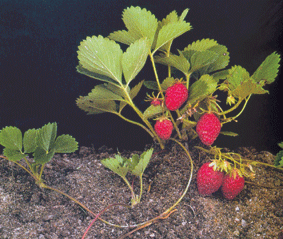Botanical Description

Taxonomy
Kingdom: Plantae
Division: Magnoliophyta
Class: Magnoliopsida
Order: Rosales
Family: Rosaceae
Subfamily: Maloideae
Genre: Fragaria
To learn about the different species, visit the "Graphs and Tables" section.
Scientific Name: Fragaria
Common Name: Strawberry
Fragaria: generic name that comes from the Latin fraga, "strawberry", which is derived from fragum, "fragrant", where it refers to the fragrance of the fruit.}
They are evergreen plants, with more or less developed epigeal rhizomes and stolons, which take root in the nodes where tri-split rosette leaves are born.
Strawberries can be diploid, tetraploid, hexaploid, octoploid, and even decaploid. Being ploidy the number of sets of chromosomes of a cell or organism

The stems are generally simple, more or less erect and annual. The leaves are grouped in false rosettes, with oval-rhombic segments, distally toothed. The inflorescences are organized in cymes with bracts. The flowers, hermaphroditic or functionally unisexual, have a receptacle with the axial zone somewhat conical, acrid and fleshy at fruiting.

The petals are obovate, not low-cut, with short nails, white, greenish-white or cream-colored. There are about 10-20 stamens and numerous free carpels implanted in the axial zone of the receptacle. The fruit is a polyachenium of ovoid achenes embedded in said receptacle (etherium) that becomes fleshy when ripe.

Properties
The weight of the strawberry varies according to the variety between 16.53 and 6.65 g and its sugar concentration ranges between 6.7 and 7.28 degrees Brix. (Table 1).
Strawberries (F. × ananassa) are
a rich source of a wide variety of compound nutrients such as sugars, vitamins and minerals, as well as non-nutritive, bioactive
compounds like flavonoids, anthocyanins, and phenolic acids.
Strawberry phenolic compounds are the best known
for its antioxidant and anti-inflammatory properties
direct and indirect action antimicrobial, antiallergic and antihypertensive properties, as well as the ability to inhibit the activities of some enzymes and physiological receptors, preventing oxidation.
All these compounds exert a synergistic and cumulative action.
effect on promoting human health and preventing disease. Of its many positive characteristics, the nutritional value of strawberries is almost perfect.
Eight medium strawberries contain more
vitamin C than an orange, 20% of the recommended daily amount of folic acid,
fat and cholesterol free, and high in fiber.
